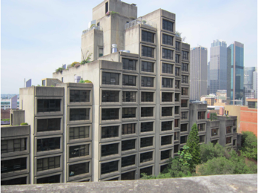- Home
- About APT
- Publications/Resources
- Conferences & Training
- Chapters
- Chapters Overview
- Alberta
- Atlantic Canada
- Australasia
- Central Plains
- APT Canada
- Delaware Valley
- Eastern Great Lakes
- Europe
- Hawaii-Pacific Islands
- Latin America and Caribbean
- Northeast
- Northwest
- Ohio Valley
- Ottawa Valley/Outaouais
- Québec
- Rocky Mountain
- South Asia
- Southeast
- Texas
- Washington D.C.
- Western Great Lakes
- Western
- Committees
- Students
- Partners
 Serius Building, Sydney, Australia, Tao Gofers, 1980.
STORIES FROM THE FRONTLINE DOWN UNDER: SOME CHALLENGES WITH CODE COMPLIANCE DURING CONSERVATION OF MODERN BUILDINGS
Thursday, January 25, 2024 David West Registration Fee Non-Members: $35 1 LU/HSW/PDH Continuing Education Unit This webinar will share examples of recent modern building conservation projects in Australia through the lens of challenges with achieving code compliance whilst simultaneously delivering good conservation practice. These issues are largely a result of trying to shoehorn existing significant fabric into the requirements of the current Australian National Construction Code (NCC) when the relevant clauses of the code were drafted 20-70 years after the buildings were originally built. Making these issues even more problematic is the changing statutory landscape in Sydney, particularly for multi-unit residential buildings, requiring design professionals (as individuals as well as firms) to certify regulated designs for the façade, structure and waterproofing of these buildings (and be liable in tort to the future owners for a period of 10 years from occupation). Challenges include:
Examples are likely to include elements such as:
David West hosts the modern building quiz at APT’s TC-MH first globally virtual happy hour in 2020. David West is a materials scientist by training, with specialist experience in the performance of materials in buildings. In his role as a Technical Director with Inhabit, one of the largest façade engineering consulting businesses internationally, he has a particular interest in the extension of life of existing building facades. In the course of the nearly four decades of his career so far, he has woven together multiple strands of expertise, including materials testing and analysis, facade design, all aspects of the use of stone in buildings, forensic investigations and expert witness services, risk assessment and risk management planning, historic preservation and heritage conservation, environmental science, stakeholder consultation, event management, business development and managing businesses. David has worked on old and new buildings throughout Australia, SE Asia, the Middle East, the United Kingdom and most recently, the US. One of his favourite modern heritage buildings is No.1 Poultry in London designed by Michael Wilford and Partners – completed in 1998 and listed Grade II* by Historic England in 2016 – David was responsible for sourcing and specifying the banded brown sandstone from Helidon in Queensland, Australia that was used on the façade. David has been active in professional organizations in Australia and internationally throughout his career, particularly in the fields of standards-writing and building conservation (preservation). A past APT International board member, and a Co-convenor of the APT Australasia Chapter, he maintains that one of the highlights of his APT involvement was hosting the quiz during the APT TC on Modern Heritage online social mixers in 2020 and 2021! Learning objectives: After attending this training course attendees will be able to: 1. Describe code compliance validation affecting modern building projects |

